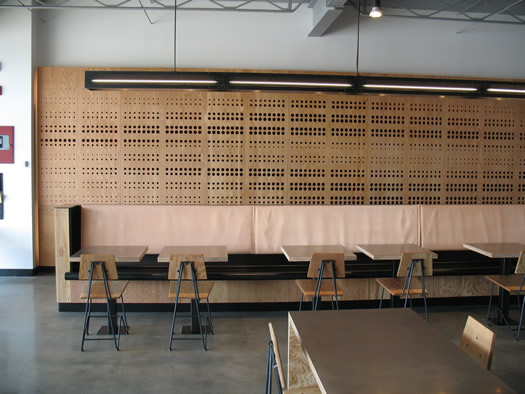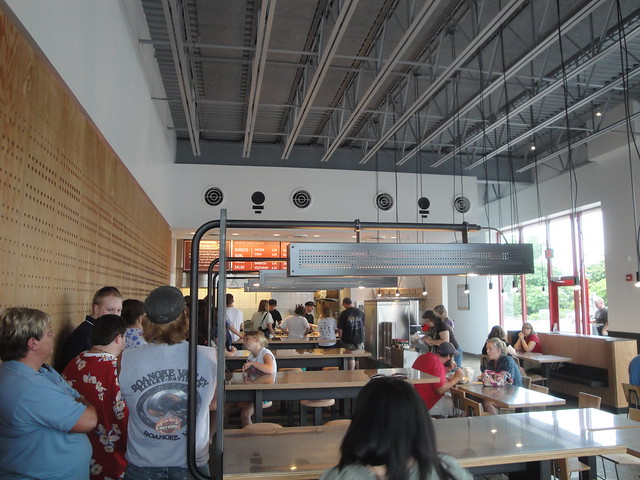| View previous topic :: View next topic |
| Author |
Message |
voicejones
Contributor III

Joined: 03 May 2005
Posts: 84
Location: Fly Over State
|
 Posted: Wed Mar 13, 2013 1:28 pm Post subject: Wall Flats Posted: Wed Mar 13, 2013 1:28 pm Post subject: Wall Flats |
 |
|
I just stumbled upon a product called Wall Flats and it looks like it could be very effective in a studio. Is anyone using it? http://www.inhabitliving.com/sample-sale-outlet.html is a link to a site that sells it. It is made from ground up sugar cane stalks, is a hard surface so there is no absorption of sound but I like the defusing aspects. What do you think?
JJ |
|
| Back to top |
|
 |
Jason Huggins
The Gates of Troy

Joined: 12 Aug 2011
Posts: 1846
Location: In the souls of a million jeans
|
 Posted: Wed Mar 13, 2013 2:14 pm Post subject: Posted: Wed Mar 13, 2013 2:14 pm Post subject: |
 |
|
That stuff sure looks cool, but I doubt it would help much in the long run with the small sized rooms and booths that VOs typically work in. Plus, you'd have to put something over it to absorb the reflection, so the aesthetics would be lost.
I'd rock some of those in my house though! |
|
| Back to top |
|
 |
Frank F
Fat, Old, and Sassy

Joined: 10 Nov 2004
Posts: 4421
Location: Park City, Utah
|
 Posted: Wed Mar 13, 2013 2:55 pm Post subject: Posted: Wed Mar 13, 2013 2:55 pm Post subject: |
 |
|
These are actually quite nice. Mio (the manufacturer) has shown they do mitigate the reflections well, but to make them better I have found a two inch piece of Auralex as backing and for absorption make these a pleasing absorber.
And they are easy to put in place and if one uses removable tape to hold the "tiles" in place they can be moved around to change the aesthetics when your mood changes.
Up until recently they were made of recycled paper products.
Frank F
_________________
Be thankful for the bad things in life. They opened your eyes to the good things you weren't paying attention to before. email: thevoice@usa.com |
|
| Back to top |
|
 |
Jason Huggins
The Gates of Troy

Joined: 12 Aug 2011
Posts: 1846
Location: In the souls of a million jeans
|
 Posted: Wed Mar 13, 2013 5:41 pm Post subject: Posted: Wed Mar 13, 2013 5:41 pm Post subject: |
 |
|
| Are they sonically transparent? I thought they were heavier duty than would allow sound transfer. That would be a different story. |
|
| Back to top |
|
 |
heyguido
MMD

Joined: 31 Aug 2011
Posts: 2507
Location: RDU, the Geek Capitol of the South
|
 Posted: Wed Mar 13, 2013 8:00 pm Post subject: Posted: Wed Mar 13, 2013 8:00 pm Post subject: |
 |
|
Think of it more like a diffuser than an absorber. Scattering the reflections yields a much different room sound than deadening them.
If you follow Frank's suggestion, you'll end up with a warmer, more natural sounding space than if you swaddled it in padding.
_________________
Don Brookshire
"Wait.... They wanna PAY me for this?" |
|
| Back to top |
|
 |
Jason Huggins
The Gates of Troy

Joined: 12 Aug 2011
Posts: 1846
Location: In the souls of a million jeans
|
 Posted: Wed Mar 13, 2013 9:30 pm Post subject: Posted: Wed Mar 13, 2013 9:30 pm Post subject: |
 |
|
| I get the diffuser, but would that really do anything in a tiny room. It would seem like it would just cause the reflection to bounce around more. I guess each bounce has some effect, but would the net effect really be worth putting them in a studio? I guess I can see the use of it in larger spaces, or for musical use. |
|
| Back to top |
|
 |
Frank F
Fat, Old, and Sassy

Joined: 10 Nov 2004
Posts: 4421
Location: Park City, Utah
|
 Posted: Wed Mar 13, 2013 10:25 pm Post subject: Posted: Wed Mar 13, 2013 10:25 pm Post subject: |
 |
|
Thanks Don. I was not clear in my explanation.
Jason there are benefits which are difficult to explain. Except to say that using foam alone is best for the mid frequencies when applied properly. Using the Mio\Inhabit squares, the reflections are dampened and depending upon the 3D structure of the tiles; will actually change the frequencies and slow them slightly.
Slow wave freq. = low freq. which means bass or boom attenuated by the foam behind the mass = nice sound in small (say 4'W x 6'L x 8'H space). Additional reflective surfaces in the room will change the efficiency of the tiles in the space.
Want to make the wall tiles approximately 75% more efficient in bass attenuation? Add a one inch standoff behind the foam so there is a dead space before the wall. Also add air space between the tiles (i.e.: don't place the tiles together and touching leave some space between them. This space will reduce the bass/boom and help the tiles become absorbers not just diffusers.
One package of ten tiles should make a small room sound sweet.
Frank F
_________________
Be thankful for the bad things in life. They opened your eyes to the good things you weren't paying attention to before. email: thevoice@usa.com |
|
| Back to top |
|
 |
voicejones
Contributor III

Joined: 03 May 2005
Posts: 84
Location: Fly Over State
|
 Posted: Thu Mar 14, 2013 7:16 pm Post subject: Wall Flats Posted: Thu Mar 14, 2013 7:16 pm Post subject: Wall Flats |
 |
|
| Frank that's good information. I've always been a fan of a great sounding room over a dead sounding booth. A good balance of absorption and reflection is tough but it's a fun challenge. I've found placing my 5 string banjo at different places in the room with headphones on and talking into the mic can really pinpoint sonic reflections problem areas. You could do the same thing with a snare drum. My current room is about 10 x 12 feet with non parallel walls and a mixture of sonex, aurelex wedges and a fuzzy blanket on the walls. I only wish I had more than 8 foot ceilings. |
|
| Back to top |
|
 |
Frank F
Fat, Old, and Sassy

Joined: 10 Nov 2004
Posts: 4421
Location: Park City, Utah
|
 Posted: Thu Mar 14, 2013 8:33 pm Post subject: Posted: Thu Mar 14, 2013 8:33 pm Post subject: |
 |
|
You are right on target. Dead is dead and so many people in our business strive for an anechoic chamber effect in their studio. In the early 1960's studio sound was influenced by this type of environment. By the 70's things had already changed and studios went for more "open" but with subdued reflections. In the mid 1980's studios were trying to find a natural sound; back then this was a definite challenge as measuring the effects of reflections was still in it's infancy.
Today many studios desire a non-obtuse sound which introduces no color but allows for a "live" feel in the recording environment. This can be difficult in a very small room such as a booth.
Your room sounds fun, Jason. A 12' x 12' studio can be perfect if you watch for extraneous reflections and hard 90 degree surfaces.
The wall flats are a great way for someone to add spice to an existing environment without spending huge money. Of course, the flats come AFTER resolving outside of the room noises and distractions.
Frank F
_________________
Be thankful for the bad things in life. They opened your eyes to the good things you weren't paying attention to before. email: thevoice@usa.com |
|
| Back to top |
|
 |
Jason Huggins
The Gates of Troy

Joined: 12 Aug 2011
Posts: 1846
Location: In the souls of a million jeans
|
 Posted: Fri Mar 15, 2013 8:48 am Post subject: Posted: Fri Mar 15, 2013 8:48 am Post subject: |
 |
|
I'm actually in an 8'x8' room for recording. Now you have me wondering. My room is DEAD...as a doornail dead. Fully surrounded by 4" Rockwool paneling on every wall and the ceiling (covering most wall space) then corner traps of triangles on top of each other from floor to ceiling with about a 24" face. Then a nice shaggy rug on the hard floor (slab, OSB, linoleum wood stuff).
Are you saying that if I were to add some (properly placed and tweaked) rigid diffusers to this room, it would create a BETTER recording environment for voice over?
I totally get the 'live' room theory for music. But I'm having a hard time wrapping my mind around the concept of ADDING reflection to a voice over studio, resulting in better sounding voice overs. I thought that the ONLY thing you wanted in your recording was your voice. Speaking strictly about voice over recording, music is a totally different animal. |
|
| Back to top |
|
 |
Frank F
Fat, Old, and Sassy

Joined: 10 Nov 2004
Posts: 4421
Location: Park City, Utah
|
 Posted: Fri Mar 15, 2013 10:12 am Post subject: Posted: Fri Mar 15, 2013 10:12 am Post subject: |
 |
|
(Chuckles) Jason, the first thing you should remember is that in the real world NATURAL means reflections. Everywhere you go - other than your booth - will have a multitude of reflections which are actually heard or felt by our ears. So the answer to your question is: Yes!
Our recordings should have minimal reflections if we desire a natural sound. These sounds should be as natural and not boomy as possible. Oftentimes this is forgotten by the engineers who design audio environments or those who do-it-themselves. I know I did with my first couple of studios I created many years ago.
Achieving the ultimate natural sound is work and most times luck. After we have isolated the inside of the room from extraneous sounds; we then must deal with the inside of the environment. The simplest thing to do is create a dead room. Others will begin adding desks and chairs and monitors and other hard surfaces then try to dampen the reflections - again. At this point in studio development most folks stop.
By "tuning" the room you will find where a bright, tight, full sound is achievable. Well placed reflective surfaces - Not at a 90 degree angle to the microphone; will brighten the room sound for recording.
The wall flats have a 3D surface and when optimized can be just the ticket for a small studio. The flats disperse the sound naturally and will leave the "body" frequencies alive.
I could go on and on but I hope this helps you understand acoustics in a small room better and how this applies to VO.
Frank F
_________________
Be thankful for the bad things in life. They opened your eyes to the good things you weren't paying attention to before. email: thevoice@usa.com |
|
| Back to top |
|
 |
heyguido
MMD

Joined: 31 Aug 2011
Posts: 2507
Location: RDU, the Geek Capitol of the South
|
 Posted: Fri Mar 15, 2013 10:45 am Post subject: Posted: Fri Mar 15, 2013 10:45 am Post subject: |
 |
|
Nicely done, Professor.... 
_________________
Don Brookshire
"Wait.... They wanna PAY me for this?" |
|
| Back to top |
|
 |
Jason Huggins
The Gates of Troy

Joined: 12 Aug 2011
Posts: 1846
Location: In the souls of a million jeans
|
 Posted: Fri Mar 15, 2013 11:37 am Post subject: Posted: Fri Mar 15, 2013 11:37 am Post subject: |
 |
|
Gotcha! I guess the ear never hears just the source sound. There is always reflection. So, if I'm reading you right, we should be shooting for creating a room that makes you sound like the way an ear would normally hear a voice.
I could liken it to an acoustic guitar. There are harmonics and sonic qualities created by a well crafted instrument that give it a truly great tone. If it just projected the fundamental, it would be a thin and boring tone.
Now, I retire to the research cave. |
|
| Back to top |
|
 |
georgethetech
The Gates of Troy

Joined: 18 Mar 2007
Posts: 1877
Location: Topanga, CA
|
 Posted: Sun Mar 17, 2013 8:21 pm Post subject: Posted: Sun Mar 17, 2013 8:21 pm Post subject: |
 |
|
Have any of you been in a Chipotle restaurant lately? They have some interesting wall diffusion acoustic treatment. One area is treated by sheets of plywood with a series of holes in increasing size from maybe 1/8" up to 2", with the wood sheets offset from the wall by maybe 2-3". Pretty cool concept, but probably only effective in large spaces. I've been paying closer attention to restaurant treatment over the last few years. LA is lousy with spartan dining rooms that echo like a basketball court.
Check this out:


_________________
If it sounds good, it is good.
George Whittam
GeorgeThe.Tech
424-226-8528
VOBS.TV Co-host
TheProAudioSuite.com Co-host
TriBooth.com Co-founder |
|
| Back to top |
|
 |
|





